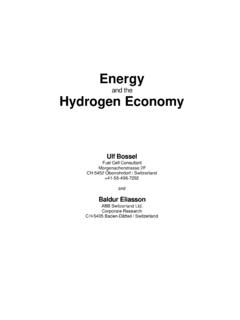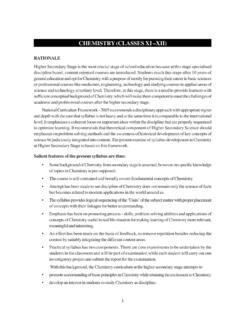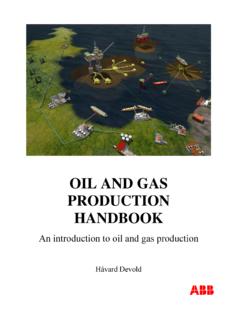Transcription of Techno-Economic Analysis of Biomass Fast Pyrolysis to ...
1 NREL is a national laboratory of the Department of Energy, Office of Energy Efficiency & Renewable Energy, operated by the Alliance for Sustainable Energy, LLC. Contract No. DE-AC36-08GO28308 Techno-Economic Analysis of Biomass Fast Pyrolysis to Transportation Fuels Mark M. Wright, Justinus A. Satrio, and Robert C. Brown Iowa State University Daren E. Daugaard ConocoPhillips Company David D. Hsu National Renewable Energy Laboratory Technical Report NREL/TP-6A20-46586 November 2010 NREL is a national laboratory of the Department of Energy, Office of Energy Efficiency & Renewable Energy, operated by the Alliance for Sustainable Energy, LLC.
2 National Renewable Energy Laboratory 1617 Cole Boulevard Golden, Colorado 80401 303-275-3000 Contract No. DE-AC36-08GO28308 Techno-Economic Analysis of Biomass Fast Pyrolysis to Transportation Fuels Mark M. Wright, Justinus A. Satrio, and Robert C. Brown Iowa State University Daren E. Daugaard ConocoPhillips Company David D. Hsu National Renewable Energy Laboratory Prepared under Task No. Technical Report NREL/TP-6A20-46586 November 2010 NOTICE This report was prepared as an account of work sponsored by an agency of the United States government.
3 Neither the United States government nor any agency thereof, nor any of their employees, makes any warranty, express or implied, or assumes any legal liability or responsibility for the accuracy, completeness, or usefulness of any information, apparatus, product, or process disclosed, or represents that its use would not infringe privately owned rights. Reference herein to any specific commercial product, process, or service by trade name, trademark, manufacturer, or otherwise does not necessarily constitute or imply its endorsement, recommendation, or favoring by the United States government or any agency thereof.
4 The views and opinions of authors expressed herein do not necessarily state or reflect those of the United States government or any agency thereof. Available electronically at Available for a processing fee to Department of Energy and its contractors, in paper, from: Department of Energy Office of Scientific and Technical Information Box 62 Oak Ridge, TN 37831-0062 phone: fax: email: Available for sale to the public, in paper, from: Department of Commerce National Technical Information Service 5285 Port Royal Road Springfield, VA 22161 phone: fax: email: online ordering: Cover Photos.
5 (left to right) PIX 16416, PIX 17423, PIX 16560, PIX 17613, PIX 17436, PIX 17721 Printed on paper containing at least 50% wastepaper, including 10% post consumer waste. iii Foreword The purpose of this Techno-Economic Analysis is to determine the economics of converting Biomass to transportation fuel components via fast Pyrolysis . Every effort has been made to place this Analysis on an equivalent basis with other Biomass conversion technologies analyzed in separate reports by using common assumptions. The process design and parameter value choices underlying this Analysis are exclusively based on public domain literature.
6 Accordingly, the results should not be interpreted as optimal performance of mature technology, but as the most likely performance given the current state of public knowledge. iv Acknowledgments This study was made possible by support from ConocoPhillips Company under project number 2007-P-01 and from the National Renewable Energy Laboratory. We would like to acknowledge the Department of Energy Office of Energy Efficiency and Renewable Energy s Biomass Program. We appreciate the helpful comments of Andy Aden, Christopher Kinchin, and Mary Biddy from NREL, and Richard Jefferys and Lou Burke from ConocoPhillips Company.
7 V List of Acronyms ASPEN Advanced Simulator for Process Engineering (software) bbl barrel BTU British thermal unit DB declining balance DOE Department of Energy ESP electrostatic precipitator GGE gallons of gasoline equivalent IC indirect costs IRR internal rate of return IRS Internal Revenue Service MACRS (IRS) Modified Accelerated Cost Recovery System MM million MT metric ton NCG non-condensable gas NREL National Renewable Energy Laboratory PV product value TEIC total equipment installed cost TPI total project investment USDA Department of Agriculture VOCs volatile organic compounds vi Executive Summary The purpose of this study is to develop Techno-Economic models for assessment of the conversion of Biomass to valuable fuel products via fast Pyrolysis and bio-oil upgrading.
8 liquefaction of Biomass by fast Pyrolysis and subsequent upgrading of the resulting Pyrolysis oil (bio-oil) by hydrotreating and hydrocracking refinery processes that use hydrogen to remove impurities and break large molecules down to smaller ones is a promising means for producing renewable transportation fuel. The upgrading process assessed in this study produces a mixture of naphtha-range (gasoline blend stock) and diesel-range (diesel blend stock) products. This study develops Techno-Economic models and uses them to analyze the economics of two scenarios.
9 In one, hydrogen needed for the upgrade process is produced onsite by reforming bio-oil. In the other, the hydrogen is purchased from an outside source. Both scenarios are based on a fast Pyrolysis plant with bio-oil upgrading using 2,000 metric tons per day (MT/day) of corn stover feedstock. Major assumptions made for this Analysis match those of companion analyses for producing transportation fuel from Biomass via biochemical and gasification technologies. Product value defined as the value of the product needed for a net present value of zero with a 10% internal rate of return is first calculated for a mature industry or nth plant and then adjusted for a pioneer plant or one of the first of its kind.
10 The study results indicate that petroleum fractions in the naphtha distillation range and in the diesel distillation range are produced from corn stover at a product value of $ ($ ) with onsite hydrogen production or $ ($ ) with hydrogen purchase. These values correspond to a $ ($ ) cost to produce the bio-oil. Based on these nth plant numbers, product value for a pioneer hydrogen-producing plant is about $ ($ ) and for a pioneer hydrogen-purchasing plant is about $ gal ($ ). Although these results suggest that Pyrolysis -derived biofuels are competitive with other alternative fuels, the technology is relatively immature, resulting in a high level of uncertainty in these estimates.














